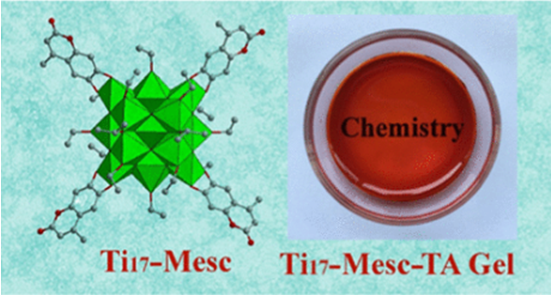Photocurrent and Gelation Properties of Polyphenol-Modified Titanium-Oxo Compounds
Hang-Ling Zhai, Jin-Le Hou, Chen-Yue Luo, Li-Jun Ma, Qin-Yu Zhu*(朱琴玉), and Jie Dai*(戴洁)
College of Chemistry, Chemical Engineering and Materials Science, Soochow University, Suzhou 215123, People’s Republic of China
Inorg. Chem.2022, 61, 13191--13198
Organic–inorganic hybrid metal–polyphenols as stable structural modules have gained extensive interest due to their diverse applications. However, titanium-oxo compounds (TOCs) with large molecular polyphenols have been less explored, and they were expected to be different from small polyphenols with isolated metal ions. Herein, 4-methyl-esculetin (Mesc), a catechol derivative, was selected to construct three TOCs, namely, [Ti17O24(Mesc)4(OiPr)16] (1), [Ti12O14(OiPr)18][Ti16O14(Mesc)12(OiPr)14] (2), and [Ti3O(Mesc)2(OAc)2(OiPr)4] (3). These compounds were structurally characterized. Photocurrent responses were evaluated using the compound-sensitized TiO2 electrodes. It was found that the current densities of 1–3 electrodes are in the order of 1 ≫ 3 > 2, which relates to the ligand-to-TiO core and ligand-to-ligand charge transfers (LMCT and LLCT, respectively). Density functional theory calculations showed that the lowest band gap of 1 originates from its LLCT. Compound 1 reacted with polyphenol tannin (TA) to form a fully transparent and robust gel (1–TA), and the gelation properties were investigated. Using the gel as a nano-TiO2 fixing agent, solar cell electrodes were prepared by a low-temperature wet method. The photocurrent responsive behavior of the 1–TA/TiO2 electrode was compared with that of the 1-sensitized traditional high-temperature-treated TiO2 electrode. Although the current density of the former is somewhat lower than that of the traditional electrode, the low-temperature wet preparation of the 1–TA/TiO2 electrode is more energy-efficient and sustainable.

链接://pubs.acs.org/doi/10.1021/acs.inorgchem.2c02086